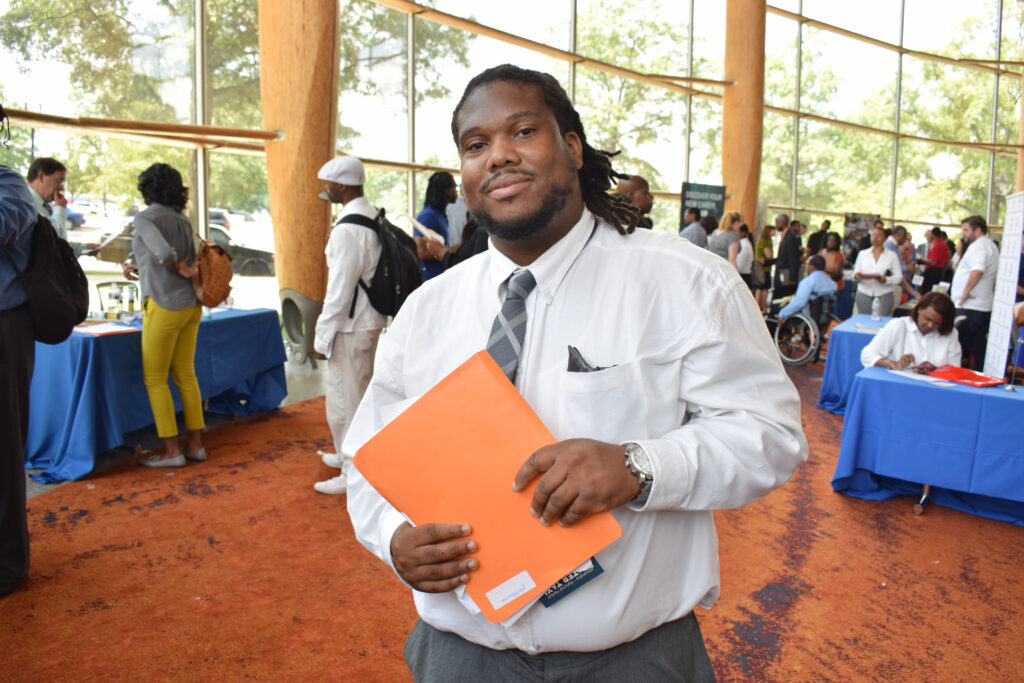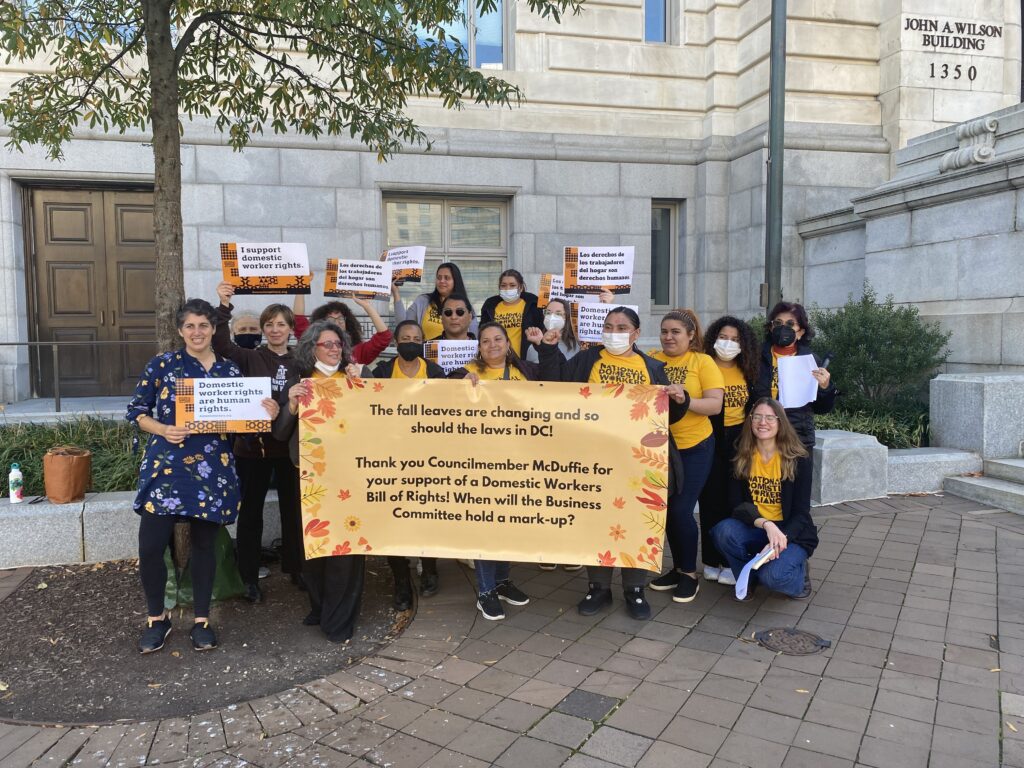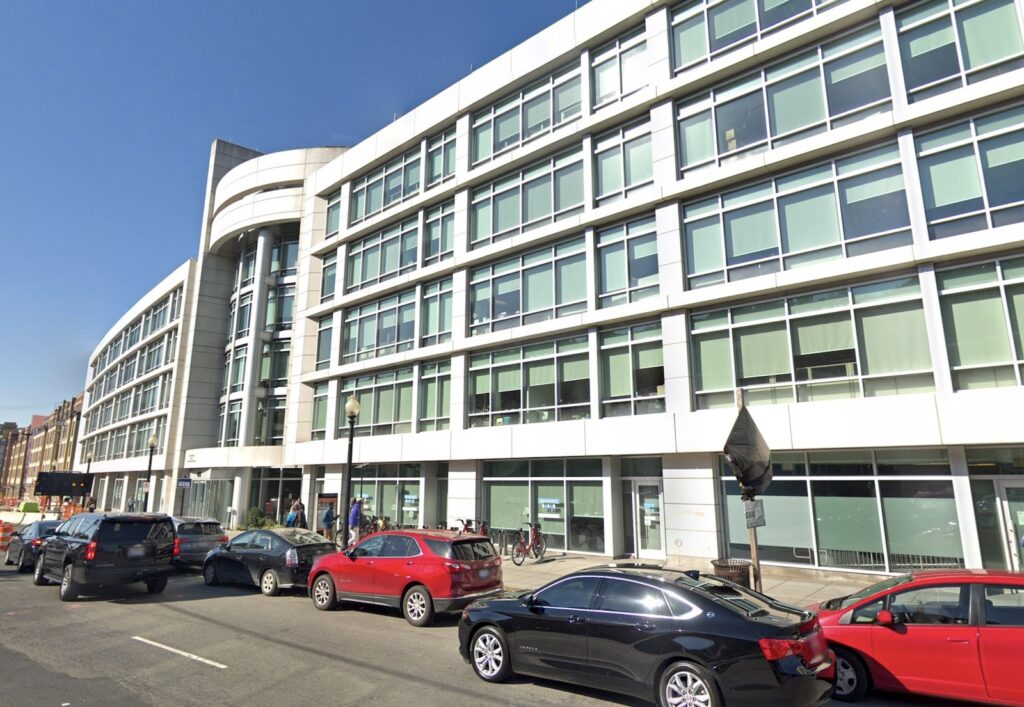Yulyia Demetria needed a job.
She didn’t need training, having worked in customer service before. She didn’t need to spend a year learning hard skills. She just needed a steady income to move herself and her son out of a domestic violence shelter.
If Demetria had joined almost any other workforce training program, she might have spent 10 weeks learning how to install solar panels or getting a commercial driver’s license. Most of the dozen or so programs funded by the D.C. government assume participants lack the training, education, experience and skills to qualify for jobs. For instance, if she participated in Project Empowerment, a program designed to help D.C. residents with barriers to employment, Demetria might have had to attend a three-week job readiness workshop to learn the skills she already possessed — all while making a small training wage that’s below minimum wage.
Instead, Demetria connected with AimHire — a different kind of workforce development program offered by Friendship Place, a local housing service provider. AimHire, which Demetria joined in December 2021, connects participants with jobs in three months or less. Instead of assuming people need extensive training to be employable, AimHire assumes people already have the skills to find steady jobs.
Putting jobs first
When Demetria connected with an employment specialist at AimHire, she was hoping to find a job in customer service, a field she’d worked in before. The process started with an initial screening to see what kind of help she required for her job search.
The AimHire program — distinct from the newly established Jobs First, a D.C. government-run pilot inspired by AimHire — is open to anyone in D.C. looking for a job. Friendship Place hosts orientation sessions for the AimHire program every Wednesday, according to Sean Read, chief program officer at the organization. Upon completing the orientation, participants are connected with specialists for screenings to see if they need help with a resume or with interview preparation before they start applying to jobs from home. Unlike most job training programs, there’s no set list of requirements someone has to complete before AimHire connects them with employers. The initiative skips the usual weeks of hard-skill training and goes straight to any needed assistance with resume development and interview preparation, encouraging participants to interview for jobs within a month.
“We believe everyone has a skill set or some form of strength that can be leveraged into an employment opportunity,” Read said.
This approach parallels the Housing First model that is popular among homeless service providers in D.C. In the same way that Housing First regards housing as a prerequisite to addressing issues of substance abuse, behavioral health or employment, AimHire regards a steady paycheck as a prerequisite for stability.
Among AimHire’s current participants, 70% are experiencing homelessness or housing insecurity. As it’s turned out, all participants in the program already have work experience, a fact that staff members attribute to a median age of 52 for single adults experiencing homelessness in D.C.
Jean-Michel Giraud, president and CEO of Friendship Place, bristles at employment programs that ask trained workers experiencing homelessness to spend six weeks learning from people who have less work experience than the participants they’re training. Not only can that disempower job seekers by implying they are less qualified than they are, but it also delays the day they can actually start applying for jobs and making money.
“The time we use is not our time,” Giraud said. “The time we use is the people’s time. And we have to treat it with respect.”
The AimHire model is more flexible than training programs that define success solely as connecting participants with full-time jobs. AimHire instead sets the goal as “meaningful employment,” which can be defined by the participant as part-time or seasonal work.
Richard McKey, assistant director of the AimHire program, prioritizes connecting participants with jobs that pay a living wage and are near their housing or other support systems. Personalizing the job-seeking experience also lets AimHire job specialists help their clients overcome small barriers. More than once, McKey has paid for Ubers when clients are running late to a job and worried about being fired.
“It’s a very time-conscious, person-centric, solutions-driven model that’s also very cost-effective,” Giraud said.
Friendship Place’s AimHire program is the first of its kind in the country and has helped inspire a burgeoning workforce development model known as “Jobs First.” The organization has presented at conferences around the country, has trained over 30 area organizations on the model, and has now caught the attention of the D.C. government.
Making it work
Demetria’s search started slowly. At the time, her son was struggling to adapt to day care, meaning she would often have to pick her son up only an hour or two after dropping him off. That took away from time she planned to spend applying for jobs and working on her resume.
Unsure of when she’d be able to commit to full-time work given her son’s unpredictable schedule, Demetria was hesitant to apply to jobs. She didn’t know if she’d have the availability. This was the hardest part of the process, she said — since she wasn’t making much progress, her employment specialist at one point suggested deferring Demetria’s participation in the program for a few months. But Demetria opted to persist.
Every week, she sent logs of her job applications to her employment specialist. After a while, they got to know each other. The specialist would recommend places to look for jobs, like day cares and children’s centers. She also called Demetria at least once a week to ask about her son.
“I like that she kept me accountable,” Demetria said. “We were just always in communication.”
Most participants send out their first job applications in the first week of being in the program, according to David Vicenty, the AimHire division director. The team of three to four staff provide information on hiring fairs and job postings, pushing participants to apply to 10 jobs a week. If job seekers do that, McKey said, they can expect to get interviews within one or two months. With applications to the right jobs and good interview skills, participants are likely to get offers after five interviews. This timeline means most people are hired within 90 days — a similar benchmark to the time it takes to be matched to housing under Housing First.
After participants are hired, AimHire helps them transition to the work environment, funds the initial costs of starting a job — like transportation and professional clothes — and checks in every three months for a year. The program can serve up to 120 people at a time and is often near capacity.
“If you really have little to start with, they can help with so much,” Demetria said.
Jobs first with strings attached
When the D.C. Department of Employment Services (DOES) released its Request for Applications (RFA) for a “Jobs First” pilot program in January, it differed greatly from the kind of program Giraud had envisioned.
Inspired by the success of AimHire, the D.C. Council had funded a small pilot in fiscal year 2022 to provide $500,000 in grants to organizations running similar job placement programs. Last month, DOES announced two grantees — Friendship Place and Byte Back, a tech-focused job training organization — to serve 75 participants each.
“We believe the current RFA does not capture the essential part of the Jobs First model,” Giraud testified at a Feb. 14 oversight hearing on DOES’s performance. The parameters set forth by the agency, he told members of the D.C. Council’s Committee on Labor and Workforce Development, departed from the AimHire model by not including a mandate for quick employment and by allowing for vocational training. Giraud likened the DOES program to traditional job placement and said the agency would need to issue a new RFA to set up a true Jobs First pilot program.
AimHire accepts anyone looking for a job, while the Jobs First program as laid out in the RFA only accepts people who are unemployed and have a barrier to employment, such as past involvement with the criminal justice system or housing instability. The Jobs First program launched by D.C. also uses full-time employment as a benchmark and places emphasis on job retention, asking nonprofits to meet placement and retention thresholds. These differences led Giraud to conclude that DOES had not fully understood the AimHire program when they attempted to expand it.
DOES Director Unique Morris-Hughes responded to the objections at a hearing on Feb. 18, insisting the RFA was developed correctly and the program would go forward as planned. After Friendship Place was awarded a grant, Giraud declined to speak further about his previous criticisms. Some of these concerns seem to have dissipated at least to some degree: Read described DOES’s Jobs First description as “an arm’s reach from what we do.”
The Jobs First model soon faced a new challenge: In her FY 2023 proposed budget, Mayor Muriel Bowser cut all funding for the second year of the two-year pilot. The D.C. Council restored the money — $606,000 — in the revised budget that won initial approval on Tuesday, with a final vote scheduled later this month. But no matter what happens, Friendship Place intends to keep running AimHire.
Measuring success
The goal of “90 days to a job” doesn’t work for everyone, Vicenty admits. Some participants sign up only to realize they need more technical training. Others fall out of communication or stop applying to jobs. But most participants have success stories. In FY 2021, the program enrolled 160 people and placed 120 with jobs, a success rate of 75%. While benchmarks for success differ across job placement programs, programs with a training-based model typically see success rates between 50% and 60%. Since AimHire began in 2011, it has placed 1,200 people into jobs.
One of those is Demetria. She found her current position, working the front desk at a pediatrics office, on the job-hunting website Indeed two months ago. While it wasn’t a job AimHire identified, she credits the support she received with helping her search. Demetria believes she could have found a job on her own — an assertion AimHire employees agree with — but said the program gave her motivation to look for jobs more regularly and apply to jobs for which she didn’t initially think she was qualified.
“They definitely helped me feel more secure and confident in my search,” she said.
This is a common feeling among participants who just need help making themselves more marketable, according to McKey.
“They’re really good at doing their job; they’re not always as good at showing an employer that they are good at doing that job,” he said.
Demetria and her son have now moved out of the shelter and into an apartment of their own. She enjoys going to work and having colleagues after two years of being a stay-at-home mom, and is hoping to take classes in the future to help her obtain a higher-paying job.
“There is still a way to go, but it is a beginning,” Demetria said. “And I like that we have our routine and stability.”
This article was co-published with The DC Line. A different version appeared in print.
Annemarie Cuccia covers DC government and public affairs through a partnership between Street Sense Media and The DC Line. This joint position was made possible by The Nash Foundation and individual contributors.








